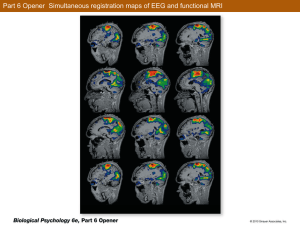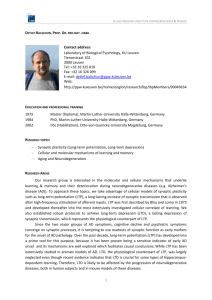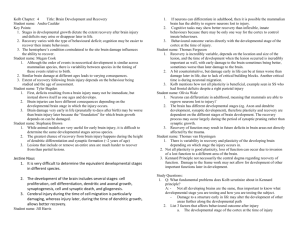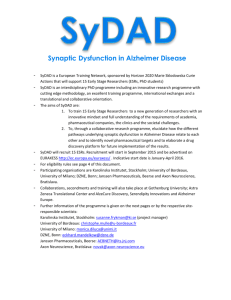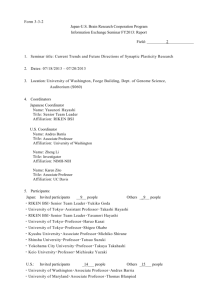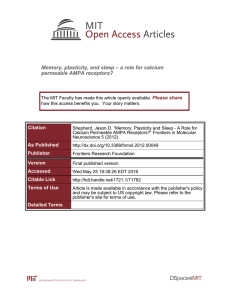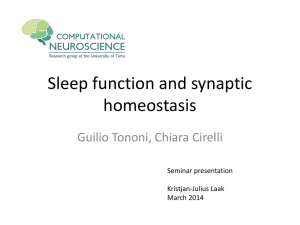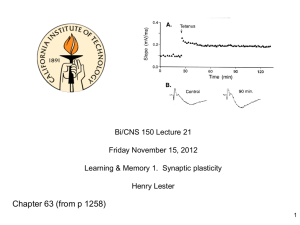Lect12
advertisement
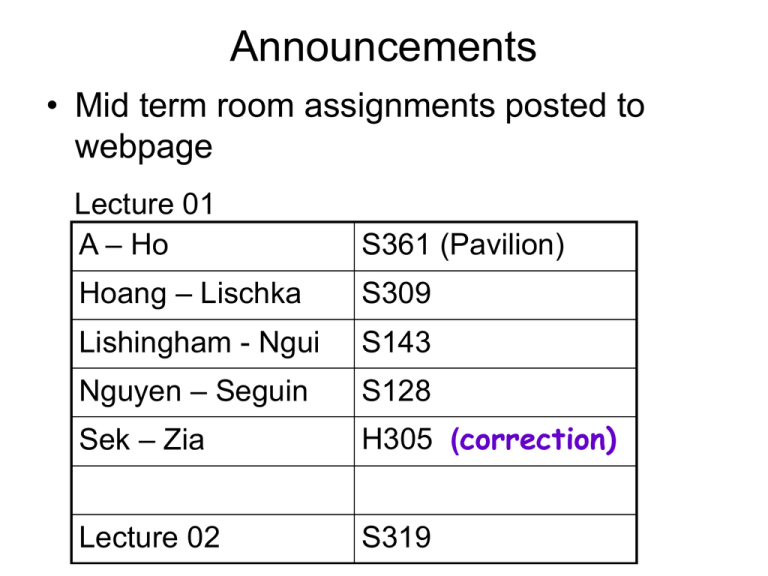
Announcements • Mid term room assignments posted to webpage Lecture 01 A – Ho S361 (Pavilion) Hoang – Lischka S309 Lishingham - Ngui S143 Nguyen – Seguin S128 Sek – Zia H305 (correction) Lecture 02 S319 • • • • Office hours: today 2-4pm, Wed 11-12 TA Office hours: Wed 12-1 Tutorial Thurs – extra office hours only Answers to practice questions will be posted later today • Bring a calculator to the midterm test – Scientific OK ; Not programmable • Midterm schedule conflicts – Wednesday 5pm deadline – bring your ROSI timetable • Material on midterm – end of today’s lecture • Last Lecture – Synaptic integration • Spatial & Temporal Summation • Today – Synaptic Plasticity Synaptic Plasticity Summation Synaptic inputs Soma and dendrites Axon Hillock Passive current flow Above threshold? Yes Action Potential No Passive Current Decays to zero Synaptic Plasticity • Changes in the strength of synaptic transmission associated with activity or experience • Basis for behaviour such as learning and memory Types of synaptic plasticity 1. Heterosynaptic Modulation 2. Long-term Potentiation 3. Homosynaptic Modulation 1. Facilitation 2. Post-tetanic Potentiation Heterosynaptic facilitation • Aplysia californica (sea slug) Aplysia (sea slug) gill withdrawal reflex • Tap the tail and the gill is withdrawn weakly • Tap the head and then the tail the gill is withdrawn strongly Heterosynaptic facilitation • Aplysia (sea slug) gill withdrawal reflex Sensory neuron Head tail Gill Muscle serotonin interneuron Sensory neuron Motor neuron Heterosynaptic facilitation 1. 2. 3. 4. 5. 6. Serotonin released from interneuron cAMP in sensory nerve terminal Closes potassium channels Delays repolarization of action potentials Allows more Ca++ to enter the nerve terminal More transmitter release Tail Sensory Neuron Action potential After Serotonin Broader AP allows more Ca++ in Motor Neuron Synaptic potential Long-term Potentiation • Mammalian hippocampus, and other brain regions • Hippocampus is a structure that is important for learning, especially spatial learning Long-term Potentiation EPSP Amplitude • Long-lasting increase (hours to days) in synaptic strength following short high frequency stimulation 200% 100% 100 Hz Time 2 hours Long-term potentiation • Depends on two types of glutamate receptors 1. AMPA • • permeable to Na+, K+ Function under all conditions 2. NMDA • • • Permeable to Na+, K+, and Ca++ BUT normally blocked by Mg++ Only operate under high frequency stimulation Normal Stimulation Na+ Mg++ NMDA AMPA Strong Stimulation Ca++ Mg++ Na+ Ca++ Ca++ NMDA Depolarization AMPA Ca++ activates second messenger NMDA receptor • Key Points 1. Normally blocked by Mg++ 2. Strong depolarization removes Mg++ and allows Ca++ to enter postsynaptically 3. Ca++ activates second messenger pathways that strengthen synaptic transmission • Probably activates more AMPA receptors Homosynaptic Modulation Facilitation • Use-dependent increase in synaptic transmission • eg. two stimuli are applied to a motor nerve in rapid succession, the second response is bigger than the first • Not the same as temporal summation Facilitation Synaptic potentials 2 1 Stimuli close together Amplitude of 2 is greater than amplitude of 1 Stimuli farther apart – amplitudes are the same Why get facilitation? • If two stimuli are close together there is an accumulation of Ca++ inside the presynaptic nerve terminal – Called residual calcium • If the two stimuli are far apart the Ca++ from first stimulus dissipates before second stimulus • Lasts for seconds Na+ Ca++ Depolarization Ca++ Ca++ Na+ Ca++ Depolarization Post-tetanic potentiation • Tetanic stimulation high frequency (50 – 100 times per second) • Lasts for minutes Normal Ca++ saline EPSP Amplitude Test stimuli 1 / 30 sec Potentiation depression 0 50 Hz for 1 min 10 minutes Time Post-tetanic potentiation Initial test stimuli establish baseline During tetanus High release depletion of vesicles Post-tetanus Replenishment of Vesicles by recycling Accumulation of internal Ca++ Greater release due to high internal Ca++ Summary • Synaptic plasticity is a use-dependent change in synaptic strength • Heterosynaptic plasticity – one synapse modulates another – Aplysia gill withdrawal reflex • Homosynaptic plasticity includes: facilitation and potentiation – Both depend on calcium
